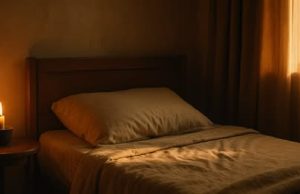
A questioner asked:
What is this fixture discovered on the closet floor? My home was constructed in 1937. Is there any idea?
Further information from the questioner:
The closet is placed between the kitchen and what was once the dining room. The dining area features a call button in the center that you can use with your foot to summon servants.

Here are some people’s opinions on it:
It could be the bottom socket on an antique, vertical shoe tree.
Perhaps an antique fitting for a gas appliance? Is there a visible pipe in the ceiling of the floor below?
If you look at the floor, you can see a roughly 3’x1′ area in front of the flange with shinier varnish. It would not be a radiator because they have two lines, one supply and one return. Based on the fact that the outline is centered in the closet and has only one line leading to it, I believe the area was designed for a gas fireplace or furnace, which is where the gas line came in.
When I asked my mother (73), if she had ever seen anything like it, she said she thought it would open something in the floor. She suggested inserting a pin in that tiny hole and spinning it. I’m not sure if that actually detects anything, but it would be intriguing.
Is there an electrical wire inside there? It appears like a fixed electrical plate. Given its location, it could have been a butler’s pantry with a tiny cabinet containing power for warmers, coffee urns, and so on.
I believe it was a butler’s pantry located between the kitchen and dining room. You can see the lighter flooring on the sides of the cabinets and countertop. Deeper cabinets on the left, shallower on the right. If it is a butlers pantry, I would guess that is the drain pipe for an ancient icebox, as butlers pantries usually housed bar supplies. Maybe?
Could be a gas line for lighting
I have the same thing in my hall closet, and I live in a 1910 farmhouse. I don’t know either!
It could be a link for a speaking tube that leads to the kitchen to request meals or to a maid’s quarters to request assistance.
Lavatory flange is similar to a closet flange but for a sink.
I’m into it. When we bought our home, there was something quite similar in the foyer. I’m a contractor, so my study revealed that it was formerly electrical in nature, but it had been deactivated long before I could determine what it could have been used for. I’m curious to see if you get this resolved. I’d echo others’ suggestions about inspecting from the ceiling below, but I wouldn’t recommend inserting anything in there. Possibly unscrew the screw.
Why would there be a heater in a closet?
Pole bracket used to support a shelf, clothing rod, or something similar vertically.
In my 1900 home, call buttons are located in the dining room, master bedroom, and all closets.
Would you be able to see the ceiling under the closet if you went down into the basement? If so, check to see if there are any wires or pipes connecting to it from below. This could either support or disprove some of the beliefs around gas lights, sink drains, electrical lighting fixtures, and so on.
This reminds me of an antique furnace damper foot lever port. Trying to find photographs online but coming up empty.
It looks like an ancient doorknob plate. Whoever claimed that a homemade shoe tree will work? Is there a hole in the side somewhere? Not in the plate connecting to the floor, but the tube part pointing up
I’m also thinking gas line. It looks like the gas port I had in my 1920s house (near the dining room wall). In photo 2, the flooring is darker and rectangular, roughly the size of the closet. It could be a result of the heat. Definitely a clue regarding the kind of appliance.
To be honest, my only two suggestions are a location where a pole of some kind would screw in and an unusual light fixture.
It appears to be a doorknob plate from the 1920s. I live in an old Craftsman home, and the cheaper brass doorknobs upstairs have plates like that. They used lower-cost, more functional fixtures above and in the basement. I have comparable iron and enamel plates for the ground-floor doorknobs.My house has a variety of strange access doors that lead to old water and (lighting) gas lines, among other things. They also kept clothes in presses and wardrobes, and their closets were often small, and I’ve seen unusual storage methods tucked beneath stairs.My house has plumbing access from the kitchen ceiling, kitchen wall, a door in an upstairs bedroom and closet, and the pantry location. Most access nowhere, since the plumbing was all shifted in the last 100 years.
What do you think? Let us know in the comment!




















